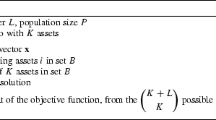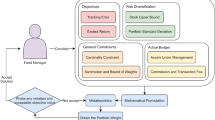Abstract
The aim of this study was to compare the performance of the well-known genetic algorithms and tabu search heuristics with the financial problem of the partial tracking of a stock market index. Although the weights of each stock in a tracking portfolio can be efficiently determined by means of quadratic programming, identifying the appropriate stocks to include in the portfolio is an NP-hard problem which can only be addressed by heuristics. Seven real-world indexes were used to compare the above techniques, and results were obtained for different tracking portfolio cardinalities. The results show that tabu search performs more efficiently with both real and artificial indexes. In general, the tracking portfolios obtained performed well in both in-sample and out-of-sample periods, so that these heuristics can be considered as appropriate solutions to the problem of tracking an index by means of a small subset of stocks.











Similar content being viewed by others
References
Aguilar-Rivera R, Valenzuela-Rendón M, Rodríguez-Ortiz JJ (2015) Genetic algorithms and Darwinian approaches in financial applications: a survey. Expert Syst Appl 42:7684–7697
Andriosopoulos K, Doumpos M, Papapostolou NC, Pouliasis PK (2013) Portfolio optimization and index tracking for the shipping stock and freight markets using evolutionary algorithms. Transp Res Part E Logist Transp Rev 52:16–34
Aouni B, Colapinto C, La Torre D (2013) A cardinality constrained stochastic goal programming model with satisfaction functions for venture capital investment decision making. Ann Oper Res 205:77–88
Barak S, Dahooie JH, Tichý T (2015) Wrapper ANFIS-ICA method to do stock market timing and feature selection on the basis of Japanese candlestick. Expert Syst Appl 42:9221–9235
Beasley JE (1990) OR-Library: distributing test problems by electronic mail. J Oper Res Soc 41:1069–1072
Beasley JE, Meade N, Chang TJ (2003) An evolutionary heuristic for the index tracking problem. Eur J Oper Res 148:621–643
Berutich JM, López F, Luna F, Quintana D (2016) Robust technical trading strategies using GP for algorithmic portfolio selection. Expert Syst Appl 46:307–315
Canakgoz NA, Beasley JE (2008) Mixed-integer programming approaches for index tracking and enhanced indexation. Eur J Oper Res 196:384–399
Cesarone F, Scozzari A, Tardella F (2013) A new method for mean-variance portfolio optimization with cardinality constraints. Ann Oper Res 205:213–234
Chang TJ, Meade N, Beasley JE, Sharaiha YM (2000) Heuristics for cardinality constrained portfolio optimisation. Comput Oper Res 27:1271–1302
Chavez-Bedoya L, Birge JR (2014) Index tracking and enhanced indexation using a parametric approach. J Econ Financ Adm Sci 19:19–44
Chen C, Kwon RH (2012) Robust portfolio selection for index tracking. Comput Oper Res 39:829–837
Chiam SC, Tan KC, Al Mamun A (2013) Dynamic index tracking via multi-objective evolutionary algorithm. Appl Soft Comput J 13:3392–3408
Connor G, Leland H (1995) Cash management for index tracking. Financ Anal J 51:75–80
Corielli F, Marcellino M (2006) Factor based index tracking. J Bank Financ 30:2215–2233
Dunis CL, Rosillo R, de la Fuente D, Pino R (2013) Forecasting IBEX-35 moves using support vector machines. Neural Comput Appl 23:229–236
Fama EF (1970) efficient capital markets: a review of theory and empirical work. J Financ 25:383–417
Filippi C, Guastaroba G, Speranza MG (2016) A heuristic framework for the bi-objective enhanced index tracking problem. Omega 65:122–137
Franks EC (1992) Targeting excess-of-benchmark returns. J Portf Manag 18:6–12
Frino A, Gallagher DR, Oetomo TN (2005) The index tracking strategies of passive and enhanced index equity funds. Aust J Manag 30:23–55
García F, Guijarro F, Moya I (2011) The curvature of the tracking frontier: a new criterion for the partial index tracking problem. Math Comput Model 54:1781–1784
Glover F (1986) Future paths for integer programming an links to artificial intelligence. Comput Oper Res 13:533–549
Guastaroba G, Speranza MG (2012) Kernel search: an application to the index tracking problem. Eur J Oper Res 217:54–68
Holland JH (1975) Adaptation in natural and artificial systems. An introductory analysis with applications to biology, control and artificial intelligence. University of Michigan Press, Ann Arbor
Hsu C (2013) A hybrid procedure with feature selection for resolving stock/futures price forecasting problems. Neural Comput Appl 22:651–671
Li Q, Sun L, Bao L (2011) Enhanced index tracking based on multi-objective immune algorithm. Expert Syst Appl 38:6101–6106
Li X, Xie H, Wang R, Cai Y, Cao J, Wang F, Min H, Deng X (2014) Empirical analysis: stock market prediction via extreme learning machine. Neural Comput Appl 27:67–78
Lindemann A, Dunis CL, Lisboa P (2005) Level estimation, classification and probability distribution architectures for trading the EUR/USD exchange rate. Neural Comput Appl 14:256–271
Lobo MS, Fazel M, Boyd S (2007) Portfolio optimization with linear and fixed transaction costs. Ann Oper Res 152:341–365
Lwin K, Qu R (2013) A hybrid algorithm for constrained portfolio selection problems. Appl Intell 39:251–266
Maringer D, Kellerer H (2003) Optimization of cardinality constrained portfolios with a hybrid local search algorithm. OR Spectr 25:481–495
Markowitz H (1952) Portfolio selection. J Financ 7:77–91
Mezali H, Beasley JE (2014) Index tracking with fixed and variable transaction costs. Optim Lett 8:61–80
Ni H, Wang Y (2013) Stock index tracking by Pareto efficient genetic algorithm. Appl Soft Comput J 13:4519–4535
Roll R (1992) A mean/variance analysis of tracking error. J Portf Manag 18:13–22
Ruiz-Torrubiano R, Suárez A (2009) A hybrid optimization approach to index tracking. Ann Oper Res 166:57–71
Sant’Anna LR, Filomena RP, Guedes PC, Borenstein D (2016) Index tracking with controlled number of assets using a hybrid heuristic combining genetic algorithm and non-linear programming. Ann Oper Res. doi:10.1007/s10479-016-2111-x
Shoven JB, Sialm C (2000) The Dow Jones industrial average: the impact of fixing its flaws. J Wealth Manag 3:9–18
Streichert F, Ulmer H, Zell A (2004) Evolutionary algorithms and the cardinality constrained portfolio optimization problem. In: Proceedings of the operations research 2003. Springer, Berlin, pp 253–260
Thenmozhi M, Sarath Chand G (2016) Forecasting stock returns based on information transmission across global markets using support vector machines. Neural Comput Appl 27:805–824
Wang M, Xu C, Xu F, Xue H (2012) A mixed 0–1 LP for index tracking problem with CVaR risk constraints. Ann Oper Res 196:591–609
Woodside-Oriakhi M, Lucas C, Beasley JE (2011) Heuristic algorithms for the cardinality constrained efficient frontier. Eur J Oper Res 213:538–550
Author information
Authors and Affiliations
Corresponding author
Ethics declarations
Conflict of interest
The authors declare that they have no conflict of interest.
Rights and permissions
About this article
Cite this article
García, F., Guijarro, F. & Oliver, J. Index tracking optimization with cardinality constraint: a performance comparison of genetic algorithms and tabu search heuristics. Neural Comput & Applic 30, 2625–2641 (2018). https://doi.org/10.1007/s00521-017-2882-2
Received:
Accepted:
Published:
Issue Date:
DOI: https://doi.org/10.1007/s00521-017-2882-2




